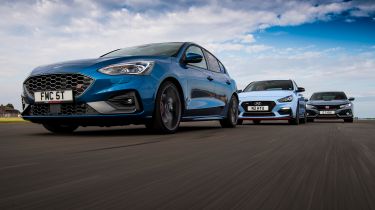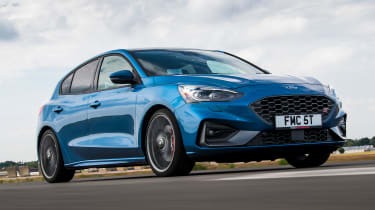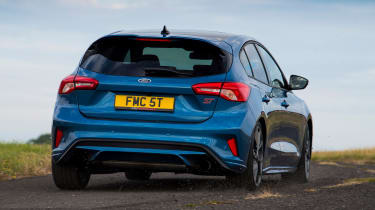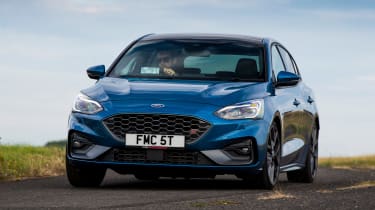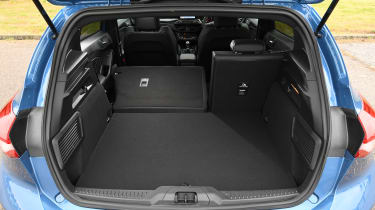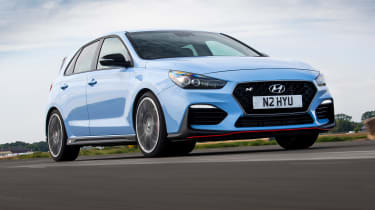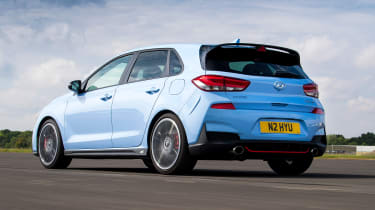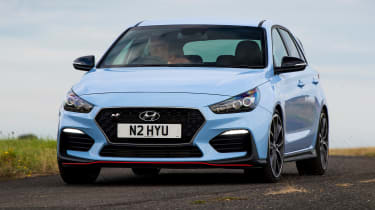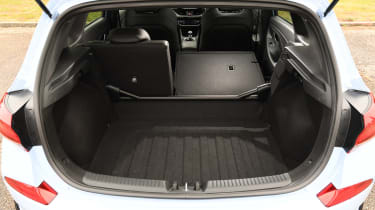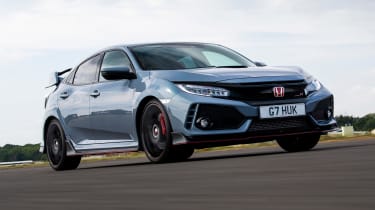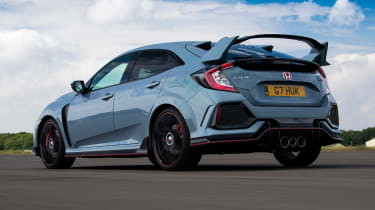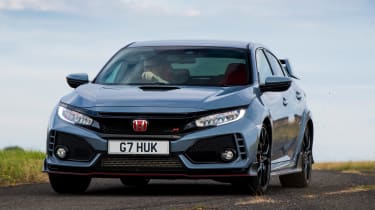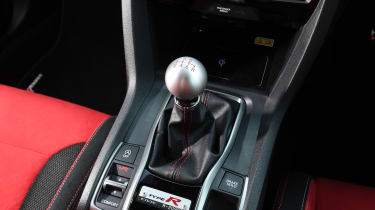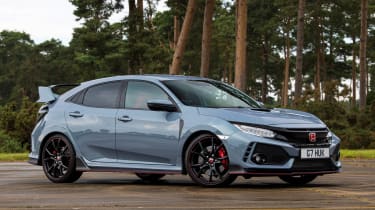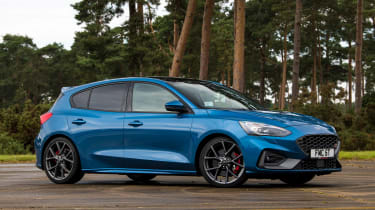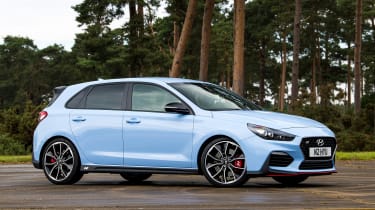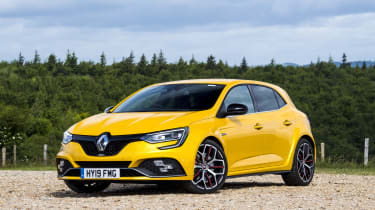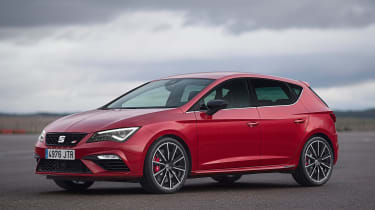Ford Focus ST vs Hyundai i30 N vs Honda Civic Type R
The Honda Civic Type R is our reigning champion and the Hyundai i30 N has proved a good first attempt, but can the new Focus ST muscle in?
The cut and thrust of the hot hatch sector is intense. There’s been a steady stream of fast, family five-door models launched over the past few years.
Each model has updated the genre with its manufacturer’s take on the recipe for a practical £30,000 performance car. Now Ford steps up to the plate with the new Focus ST.
It’s fair to say the last version was a little long in the tooth compared with newer rivals that boasted more tech and driver aids. So this new third-generation Focus ST (which is actually based on the Mk4 Focus) is back with those features. The price has climbed as a result, to the point where the latest ST is now perilously close to our class favourite, the Honda Civic Type R, which boasts more power for not much more money.
So Ford’s newcomer will have to beat our hot hatchback of the year if it wants to reign – but it’ll also have to overcome the challenge of the Hyundai i30 N Performance.
The i30 joined a select group of hot hatches with clever application of some advanced tech, much of which the Focus ST also now boasts, and it’s on this front where this battle will be won.
Ford Focus ST
| Model: | Ford Focus ST |
| Price: | £31,995 |
| Engine: | 2.3-litre 4cyl turbo, 276bhp |
| 0-60mph: | 5.9 seconds |
| Test economy: | 30.2mpg/6.6mpl |
| CO2: | 179g/km |
| Annual road tax: | £145 |
On the face of things, Ford’s £31,995 Focus ST looks a little pricey compared with its rivals. However, as we’ll see, it has the ability to back up this tag, while finance deals make it more affordable.
Used - available now

2024 Vauxhall
Mokka
9,304 milesManualPetrol1.2L
Cash £16,887
2021 Ford
Focus
33,733 milesManualPetrol1.0L
Cash £12,500
2022 Volkswagen
ID.3
26,587 milesAutomaticElectric
Cash £14,900
2024 Volkswagen
Golf GTD
29,886 milesAutomaticDiesel2.0L
Cash £23,200Design & engineering
Ford’s C2 platform on which the Focus is based is perfectly suited for the purposes of a hot hatch. That’s because while the ST uses MacPherson struts for its front suspension like pretty much every car in this class (and its rivals in this test), it has a multi-link rear axle. But then, so do both the Honda and the Hyundai.
The Ford shares plenty more in its approach to going fast with its two rivals as well, as it gets adaptive dampers as standard, and a limited-slip differential. Rather than a purely mechanical diff like the Civic, the Focus follows the i30 with an electronically controlled unit. That means you can change how aggressively it works to help agility and traction.
For the first time in a Focus ST, there are drive modes that change parameters such as throttle response and the noise the electronic sound enhancement makes to augment the engine’s soundtrack. Go for our test car’s £250 Performance Pack, and you also get launch control and rev matching for downshifts, plus an extra Track driving mode. All of the driver settings change the window of operation in which the adaptive dampers work, and Track is the most aggressive for the damping and engine.
The 2.3-litre four-cylinder turbo is an evolution of the previous Focus RS engine, although here it doesn’t make as much power, at 276bhp. However, that extra displacement over its rivals means it has the most torque, with 420Nm. There’s also an anti-lag function that helps to keep the turbo spinning to boost throttle response.
Of course, any practical and affordable performance car such as this has to deliver more than merely engineering tech. These cars will be used daily, so a decent level of kit is important, too.
There’s only one ST trim, which features great heated part-leather Recaro sports seats, climate and cruise control, parking sensors, keyless operation and LED lights – but so it should for the price. It’s £1,555 less than the Honda, yet the Ford gets a lot less power (albeit similar kit) and is £2,500 more expensive than the Hyundai, which is slightly less powerful and boasts just as much tech.
Driving
Ford Performance is known for its ability to make its cars drive superbly, and it’s turned the standard Focus – which is already a good driver’s car – into an incredibly capable one with the ST.
The chassis is at the centre of the car’s ability. There is a high level of grip courtesy of Michelin Pilot Sport 4S tyres, and in Sport or Track mode the adaptive dampers control the body brilliantly, keeping composure in quick corners and adding a sweet level of subtle adjustability that’s been engineered into the package. The ST loves to turn tighter with a little mid-corner lift of the throttle, boosting confidence.
The steering is typically fast Ford; quick and a bit squidgy. Sometimes the Focus is so eager to turn that it feels a little too alert, but you’ll welcome this darty turn-in when you start to push the pace.
There’s plenty of that, thanks to the engine. It’s not the most characterful unit, blaring loudly and exhibiting an artificial electronically enhanced note at high revs, but at least the pops from the exhaust are authentic and add some personality.
Our 5.9-second 0-60mph sprint matched the Honda’s and beat the Hyundai’s by 0.4 seconds. However, the i30 N was quicker in gear than the ST, so despite that extra torque the Ford’s weight counted against it. There’s more than enough grunt, though.
The six-speed gearbox is fine, and while the suspension is firm even in Normal mode, the damping quality is great, and closer to the Honda’s than the Hyundai’s. You do get jiggled about, but the dampers absorb a lot of imperfections smoothly. Sport and Track are firmer, though, and the range of ability isn’t as wide as the Honda’s, so it’s not as comfortable.
Practicality
With a 378-litre boot the Focus has the least practicality, but not by much. The Hyundai offers only three litres more, while rear space is similar, too. However, the Honda is much further ahead in both respects. There’s still enough room in the Ford for most occasions, though, (including for luggage), while cabin storage is good.
Practicality drawbacks come in other forms, such as manoeuvrability. The steering is fast but there’s not much lock, even though the ST has the tightest turning circle here. Tight turns will need a few bites, but parking sensors and a camera are included.
Ownership
The brand’s result in our Driver Power owner-satisfaction survey just slipped behind Hyundai in 23rd, but it trailed Honda by some margin. The ST gets a lot of standard safety tech, with AEB and lane-keep assist helping it achieve a five-star Euro NCAP rating to match its rivals. All three cars have performance brakes.
Running costs
If you’re thinking of running a hot hatch as a business user, the ST splits its rivals for company car tax contributions. There’s not much difference in CO2 emissions – the Type R and i30 N emit 178g/km, the ST 179g/km – so they all sit in the top 37 per cent Benefit-in-Kind band.
That means the decision comes down to list price. The most expensive Honda will therefore cost higher-rate earners £4,831 a year in BiK, the Ford £4,601 and the Hyundai £4,231.
Testers’ notes
“The ST’s e-diff is great. If you sacrifice a little entry speed in a corner to get it hooked up and biting hard on the way out, it’ll sling-shot you round the bend and out the other side with strong traction.”
Hyundai i30 N
| Model: | Hyundai i30 N Performance |
| Price: | £29,495 |
| Engine: | 2.0-litre 4cyl turbo, 271bhp |
| 0-60mph: | 6.3 seconds |
| Test economy: | 30.4mpg/6.7mpl |
| CO2: | 178g/km |
| Annual road tax: | £145 |
Few cars have forced established auto makers to rethink their approaches in the same way as Hyundai’s i30 N has. In £29,495 Performance trim, it has price on its side and tech to match the Focus ST.
Design & engineering
As with its rivals here, this hot Hyundai is based on the regular i30, but with significant modifications to improve performance. The basic suspension set-up is the same as the Ford’s, with struts at the front and a multi-link rear end, while the suspension is also controlled by adaptive dampers.
The Hyundai has an electronically controlled limited-slip differential, too, to better transmit the 2.0-litre turbo engine’s 271bhp and 378Nm of torque (on overboost) to the road.
There are plenty of driving modes, but unlike the ST’s predetermined four settings, pretty much everything in the i30 N is configurable. The steering weight, throttle response, diff parameters, suspension damping, exhaust sound, downshift rev matching and ESC are all adjustable, while there’s a Custom preset and an N-mode button that ramps everything up to the maximum.
This is where the heart of the i30 N lies, and he fact that you get all of this clever performance-enhancing tech for the price makes this a great, affordable performance car. Yet you can also see where corners have been cut to save some cash.
The quality isn’t as high as in either the Ford or Honda, but that might not matter to some people who are focused more on performance. What will bother them is that the sports seats aren’t as supportive and the driving position is not as good as either rival’s.
At least you get a lot of other equipment, including an eight-inch touchscreen with all of the functionality you’d expect (see Infotainment, page 50). On top of this, a heated steering wheel and seats, 19-inch alloys to match the Ford’s, a befittingly aggressive bodykit, LED lights, cruise and climate control, keyless operation, DAB, wireless charging, launch control and upgraded brakes mean it’s basically honours even with the Focus.
Driving
The i30 N trails when it comes to the driving experience, though – mainly because it doesn’t have the same depth, subtlety or adjustability as the ST.
The steering is slower and more predictable than the Ford’s, and while it’s a good weight in normal mode, it’s too heavy and resistive in the N setting. As with the Focus, you know the damping has been set up to generate huge cornering forces, but it doesn’t have the ST’s rounded edge and is very firm. There are more clonks and crashes over surfaces that the Focus is less ruffled by, but still not immune to. In N mode the damping is extremely stiff and probably best saved for track driving; we would recommend normal or Sport for the road, as this firmest setting is occasionally quite harsh. We hope the hatch adopts the i30 N Fastback’s slightly softer settings in time.
That e-diff has a similar effect as the Ford’s on performance, locking the Hyundai on to its line through corners, but traction isn’t as good as in the Focus, and the i30 is keener to spin its wheels than the ST. However, there’s still plenty of muscle, as our test figures show. The Hyundai sprinted from 0-60mph in 6.3 seconds, which is fast, but its strong in-gear grunt was impressive, splitting its rivals.
The engine is a highlight too, fizzing away with an aggressive snarl and pops from its exhaust. The i30 sounds like a little rally car, and this gives it character. The six-speed gearbox is good, too.
Ultimately, though, while the i30 N is a great, aggressive hot hatch buzzing with personality, its limits aren’t quite as high as those of the Ford’s or the Honda’s. Nor is it as rewarding or as communicative as either, so it narrowly loses out.
Practicality
Hot hatchbacks have to cover pretty much every base, and the i30 N does the practicality side of things pretty well, with 381 litres of boot space and plenty of room for passengers inside.
Although the cabin isn’t quite as nice as the ST’s, the racier looks don’t impact visibility as much (parking sensors and a reversing camera are standard, though). It’s also more manoeuvrable. Access to the rear is good, while other elements that contribute towards a car’s practicality – such as usability of the infotainment – are also sound.
Ownership
The i30 in all forms gets a full five-star Euro NCAP rating, with autonomous braking, lane-departure warning with lane-keep assist and six airbags all standard.
As with Ford, Hyundai didn’t fare too well in our Driver Power owner-satisfaction survey, though, taking 22nd spot. That’s poor for a brand that prides itself on its customer offering in the form of a five-year unlimited-mileage warranty with five years’ roadside assistance. This betters the Ford and Honda’s three-year warranties.
Running costs
According to our experts, the i30 N will depreciate the most here over a typical three-year/36,000-mile ownership period, losing £15,998. That equates to residuals of £13,497 (45.8 per cent).
However, all three cars are quite close when it comes to residual values in percentage terms. The Ford is expected to retain 46.3 per cent, or £14,826, which means it’ll shed £17,169. The Honda is the strongest, at 48.3 per cent retained value, or £16,201. Civic Type R depreciation stands at £17,349.
Testers’ notes
“At 1,429kg, the i30 N isn’t light, but the ST is heavier, tipping the scales at 1,508kg. The way Ford has set up the chassis to build in agility and work around this figure is all the more impressive.”
Honda Civic Type R
| Model: | Honda Civic Type R GT |
| Price: | £33,550 |
| Engine: | 2.0-litre 4cyl turbo, 316bhp |
| 0-60mph: | 5.9 seconds |
| Test economy: | 31.8mpg/7.0mpl |
| CO2: | 178g/km |
| Annual road tax: | £145 |
The Civic Type R is our current class champion, so this is the benchmark the latest Focus ST has to surpass. Priced at £33,550 in GT trim, the Hondais the most expensive model here, but then it does have more power and performance.
Design & engineering
We’ll address one area of the Civic we don’t like straight away; the looks. This is a subjective viewpoint, obviously, but the Focus ST and i30 N wear their performance bodykits and aerodynamic additions with a little more class than the Honda does.
However, underneath that wild bodywork, the Civic Type R is an incredible piece of engineering. The platform it’s based on features a multi-link rear axle, adaptive dampers, limited-slip differential, a wonderful six-speed manual transmission and a 2.0-litre turbocharged engine producing a whopping 316bhp and 400Nm of torque.
There are adaptive dampers present here, too, which are linked to the drive mode switch (you can choose between Comfort, Sport and +R settings). This also sharpens up throttle response as in the Honda’s rivals. There is less configurability here, but that’s no bad thing. The diff, for example, is fixed, yet it’s an extremely impressive piece of kit that amplifies what the Civic can offer on twisty roads.
The design of the interior matches that of the exterior, in that it’s a little all over the place. The infotainment, storage and a few other points seem at odds with each other and awkwardly thought out. However, the Type R gets the things a hot hatch needs to deliver absolutely spot-on. The driving position, for example, is easily the best here, with a low seat setting and plenty of support.
Some of the tech is a little lacking in its execution, though, and despite the build and the features, it all looks a little ‘last generation’, from the few digital dash gauges to the infotainment screen. At least you get a lot of equipment. All the safety tech you’d need is included, with parking sensors and a reversing camera, wireless phone charging, LED headlights and keyless operation, plus a good level of connectivity. The Honda is the priciest car here, but it’s still good value.
Driving
The Honda is also the best car to drive of this trio. It feels the most natural and the least contrived, with the driver modes having the biggest separation between extremes of the suspension’s damping and therefore the character the car takes on.
The previous Civic Type R was too firm. In Comfort, this version rides with compliance and fluidity, moving gracefully over undulations and skipping over the kind of bumps that upset the Focus and i30 more brutally. It really rides brilliantly.
In Sport, the same superbly controlled feel to the way the wheels are damped is obvious, just with a little more focus, less slack and tauter body control. It’s more eager still in +R, and while on bad roads this feels a little too much and causes the car to hop around, it’s still better than the i30 in N mode.
The steering is the best here, too. It’s the perfect speed, and means you can turn the car smoothly into bends where in the Focus you might make a more jagged input due to its quicker rack.
There’s a huge level of grip to call on, too. The ST is closer to the Civic than the i30 N in this respect, but the Honda still out-corners both cars. It doesn’t have the Ford’s instant adjustability, yet it feels more stable as a result. The diff hooks up naturally, so there’s less torque steer than in the Focus, and the Honda can easily put all of its power and torque to the road.
To cap it off, the engine is explosive, punching hard in the mid-range and revving with more vigour at higher revs than either of its rivals’ motors. The six-speed manual’s beautifully involving shift action means the Civic is as good as any sports car.
The Honda was the quickest on test, sprinting from 0-60mph in 5.9 seconds to match the Ford and blistering through our in-gear challenges. However, it’s almost academic, because it’s the way the car does this and the feel it delivers that are key to its ability.
Practicality
At 420 litres the Honda’s boot is the biggest, while there’s plenty of room in the back of the cabin. The sloping rear roofline means headroom is more limited than in either the Ford or the Hyundai, but it’s not too much of a drawback. Fold the 60:40 split rear bench (the same as the car’s rivals) and the Civic has the smallest load bay, at 1,209 litres. The ST offers 1,250 litres, while the i30 boasts 1,287 litres.
That huge wing doesn’t impact rear visibility too much, while other neat touches include the sliding rear load cover that can be removed easily. These thoughtful touches highlight some annoying ones, though, such as the awkward ledge beneath the gearlever where the USB ports are located.
Ownership
Honda’s fairly strong seventh-place result in our Driver Power owner-satisfaction survey means the brand outshone its rivals in this test. Safety tech is a match for them, and includes lane-departure warning with lane-keep assist, blind-spot monitoring, autonomous braking, cross-traffic alert and adaptive cruise. It’s the best equipped of these three as standard.
Running costs
The lighter Civic was the most efficient on test, returning 31.8mpg for an annual, 12,000-mile fuel bill of £2,216. This compares with the i30’s 30.4mpg and £2,318, and 30.2mpg and £2,334 for the Focus ST, so all three are respectably economical given the performance on offer.
Testers’ notes“Three years’ servicing on the Civic costs £599, while three services on the i30 are £523. Prices for the ST have yet to be published, but Ford’s mainstream nature means we’d expect a similar outlay.”
Verdict
First place: Honda Civic Type R
The Focus ST gets closer than ever to the Honda’s crown, but the Civic Type R’s breadth of ability and huge hit of performance means it’s still the best hot hatch out there. While its looks won’t suit everyone, it’s also the most practical and the most comfortable car here, even if its infotainment set-up is the worst. It’s the integration of chassis and powertrain that makes this package so enticing, though.
Second place: Ford Focus ST
A few factors hold the ST back, but it’s a great hot hatch defined by its adjustability. Despite its 0-60mph sprint time, the engine isn’t quite as explosive as the Honda’s, and its gearbox isn’t as accurate. The blend of ride comfort and body control isn’t as convincing, but the Ford’s cabin is nicer and the technology is stronger. Its practicality and price are slight sticking points, although finance is your friend here.
Third place: Hyundai i30 N
Time hasn’t dented the i30 N’s appeal. In fact, it still proves how good a first effort it was by Hyundai, joining established hot hatch rivals. The model is packed with character but balances this with rationality and usability, plus massive performance. However, the i30 N is just lacking a little engagement when compared with the ST, which is why the Korean brand’s hot hatch narrowly loses out here.
Also consider...
Renault Mégane R.S.
Model: Renault Mégane R.S. 300 TrophyPrice: £31,835Engine: 1.8-litre 4cyl, 296bhp
The Renault Megane R.S. is purer than the Focus ST, without such an emphasis on driver modes. While four-wheel steering helps agility, it isn’t that consistent. Firm dampers give great body control, plus the steering is sharp. It sounds good and looks the part, too.
Model: SEAT Leon Cupra LuxPrice: £31,360Engine: 2.0-litre 4cyl, 286bhp
The Leon Cupra is a little long in the tooth, but its MQB chassis is still capable enough. But the Spanish hot hatch isn’t as involving as any of our test cars; partly because you can now only get the Cupra with a DSG dual-clutch automatic gearbox.
Figures
| Ford Focus ST | Hyundai i30 N Performance | Honda Civic Type R GT | |
| On the road price/total as tested | £31,995/£33,045 | £29,495/£30,080 | £33,550/£33,550 |
| Residual value (after 3yrs/36,000) | £14,826/46.3% | £13,497/45.8% | £16,201/48.3% |
| Depreciation | £17,169 | £15,998 | £17,349 |
| Annual tax liability std/higher rate | £2,300/£4,601 | £2,115/£4,231 | £2,415/£4,831 |
| Annual fuel cost (12k/20k miles) | £2,334/£3,890 | £2,318/£3,864 | £2,216/£3,694 |
| Insurance group/quote/VED | 34/£700/£145 | 28/£431/£145 | 34/£550/£145 |
| Cost of 1st/2nd/3rd service | TBC | £141/£234/£148 | £599 (5yrs) |
| Length/wheelbase | 4,388/2,700mm | 4,335/2,650mm | 4,557/2,699mm |
| Height/width | 1,458/1,825mm | 1,447/1,795mm | 1,434/1,877mm |
| Engine | 4cyl in-line/2,261cc | 4cyl in-line/1,998cc | 4cyl in-line/1,996cc |
| Peak power/revs | 276/5,500 bhp/rpm | 271/6,000 bhp/rpm | 316/6,500 bhp/rpm |
| Peak torque/revs | 420/3,000 Nm/rpm | 378/1,750Nm/rpm | 400/2,500 Nm/rpm |
| Transmission | 6-speed manual/fwd | 6-spd man/fwd | 6-speed manual/fwd |
| Fuel tank capacity/spare wheel | 52 litres/repair kit | 50 litres/space saver | 46 litres/repair kit |
| Boot capacity (seats up/down) | 378/1,250 litres | 381/1,287 litres | 420/1,209 litres |
| Kerbweight/payload/towing weight | 1,508/492/1,600kg | 1,429/521/1,600kg | 1,380/380kg/N/A |
| Turning circle | 11.3 metres | 11.6 metres | 12.6 metres |
| Basic warranty (miles)/recovery | 3 years (60,000)/1 year | 5 years (unlimited)/1yr | 3 years (60,000)/3 years |
| Driver Power manufacturer/dealer pos. | 23rd/20th | 22nd/12th | 7th/2nd |
| NCAP: Adult/child/ped./assist/stars | 85/87/72/75/5 (’18) | 88/84/64/68/5 (’17) | 92/75/75/88/5 (’17) |
| 0-60/30-70mph | 5.9/5.0 secs | 6.3/5.2 secs | 5.9/4.3 secs |
| 30-50mph in 3rd/4th | 2.6/3.7 secs | 2.4/3.1 secs | 2.2/3.4 secs |
| 50-70mph in 5th/6th | 4.5/6.1 secs | 4.3/5.4 secs | 3.8/5.7 secs |
| Top speed/rpm at 70mph | 155mph/2,500rpm | 155mph/2,500rpm | 169mph/2,600rpm |
| Braking 70-0/60-0/30-0mph | 48.5/36.3/8.3m | 50.0/35.9/10.8m | 46.3/31.8/10.8m |
| Auto Express econ. (mpg/mpl)/range | 34.4/7.6/345 miles | 30.4/6.7/334 miles | 31.8/7.0/322 miles |
| WLTP economy combined | 35.8mpg/7.9mpl | 34.0mpg/7.5mpl | 33.2mpg/7.3mpl |
| Actual/claimed CO2/tax bracket | 216/179g/km/37% | 215/178g/km/37% | 209/178g/km/37% |
| Airbags/Isofix/parking sensors/cam | Six/yes/yes/yes | Six/yes/yes/yes | Six/yes/yes/yes |
| Auto box/lane-keep/blind spot/AEB | No/yes/£400/yes | No/yes/no/yes | No/yes/yes/yes |
| Clim./cruise ctrl/leather/heated seats | Yes/yes/yes/yes | Yes/yes/no/yes | Yes/yes/no/no |
| Met. paint/LED headlights/keyless go | £800/yes/yes | £585/yes/yes | £525/yes/yes |
| Nav/digi dash/DAB/connect. services | Yes/no/yes/yes | Yes/no/yes/yes | Yes/yes/yes/yes |
| Wireless charge/CarPlay/Android Auto | £100/yes/yes | Yes/yes/yes | Yes/yes/yes |
